Creating a Tree Object
This topic describes how to add a new Tree Object to a Screen or a Container and its specific properties.
To create a new Tree Object, you need to access a Screen in Design mode.
Once you're in the Screen editing page, locate the Tree Object from the Screen Objects list in the left panel, then drag and drop it onto your Screen or Container.
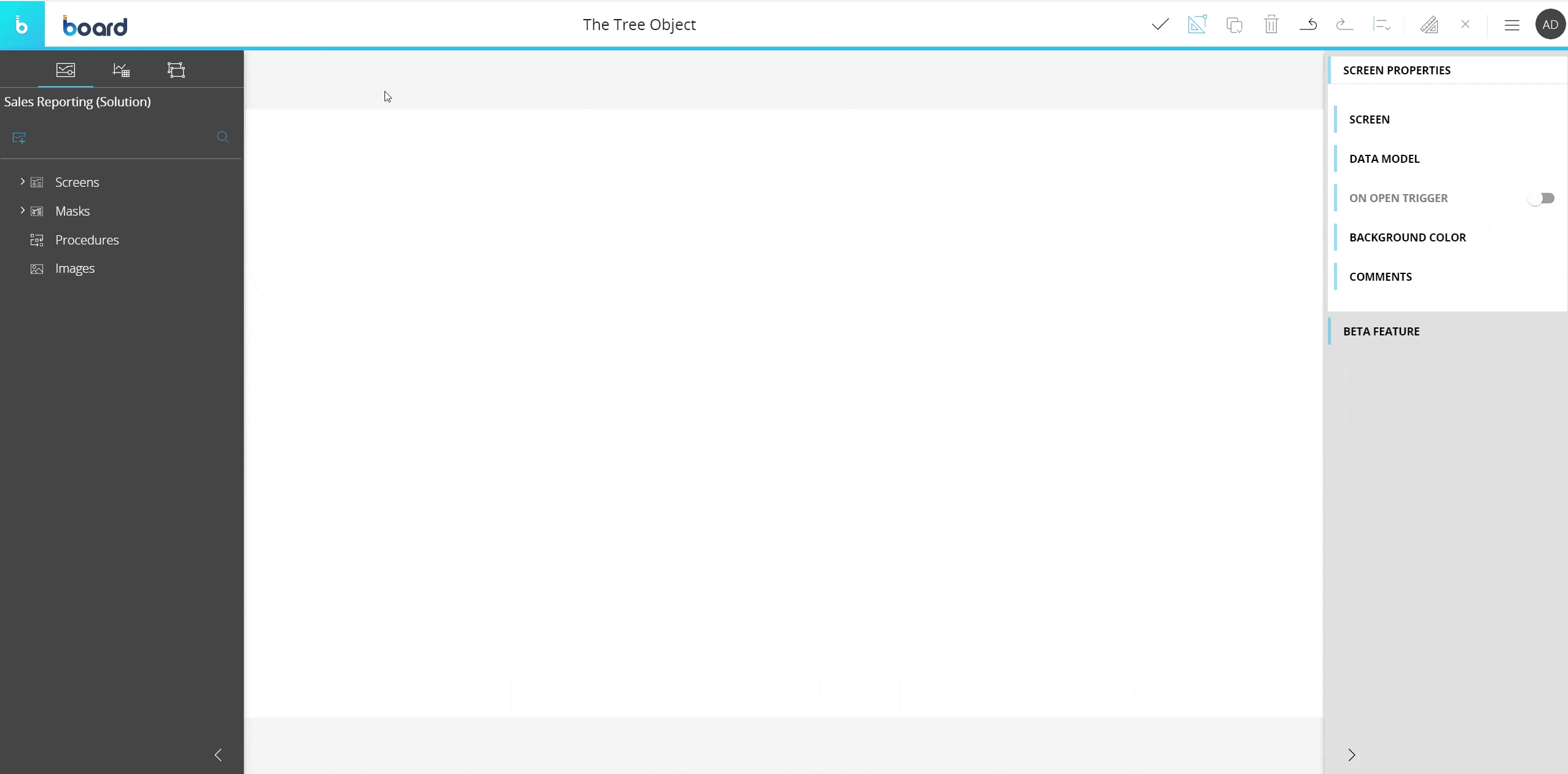
When you create a Tree Object, it is initially empty. The next step is to configure a Layout that will define the data to be displayed. To do so, select the Tree Object and click the "Configure layout" button (![]() ) located in the Top Menu of the Capsules workspace.
) located in the Top Menu of the Capsules workspace.
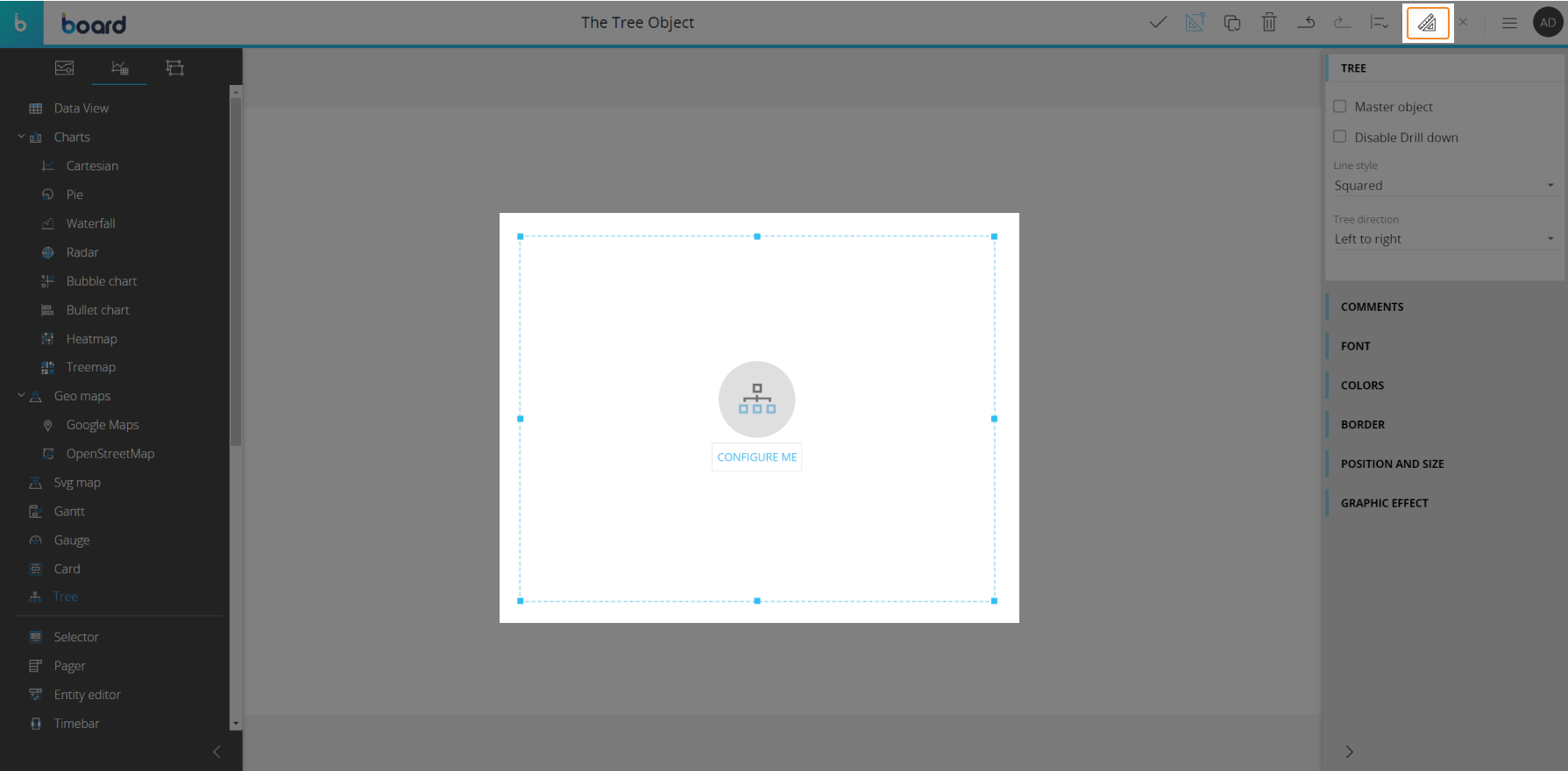
See The Layout Object, Configure a Layout and About data blocks of a Layout for more details on the Layout Object.
Tree Layout
The Layout editor for the Tree Object is slightly different from the classic one, in that it offers some Tree-specific options and properties.
Tree levels are defined by the number of Entities set By Row, while Data Blocks determine the data displayed in each box (node).
Noteworthy areas of the Tree Layout are highlighted in the image below:
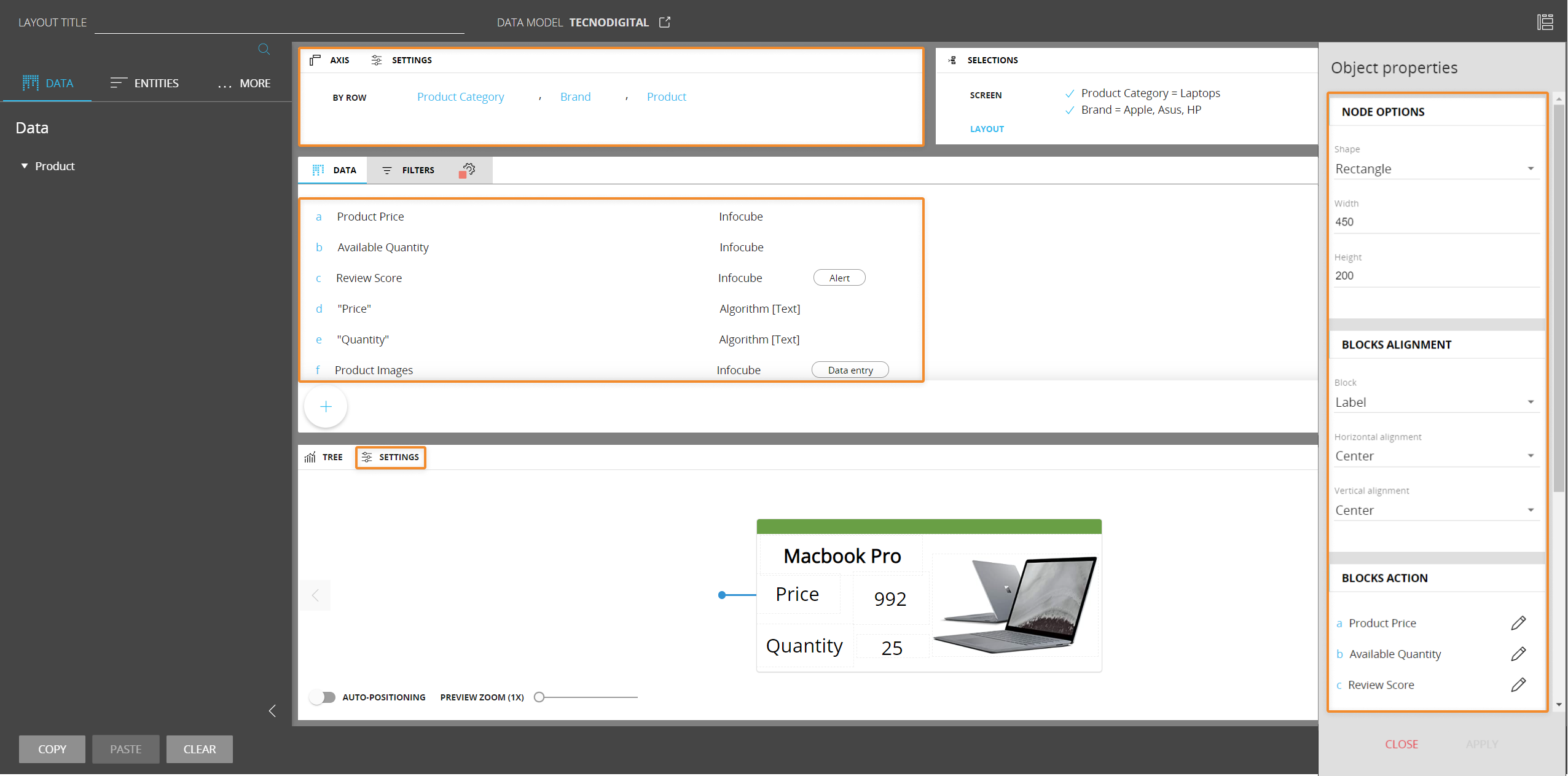
Axis area
The Tree Object requires at least only one Entity By Row and doesn't support Entities By Column.
Once an Entity is set By Row, the Tree Object will display data from all Blocks defined in the Data Area for each member of that Entity.
If you add two or more Entities By Row, Board will group them according to the following criteria:
- If Entities are related (i.e. they are part of the same hierarchy), Entity Grouping occurs automatically: the most nested Entity in a Relationship is always arranged in the rightmost position and you won't be able to rearrange their order. The least nested Entity will be the root node of the diagram, while the most nested Entity will be shown at the leaf node level
- If Entities are not related, you can freely rearrange their order in the field: to do so, drag and drop them in the desired position. The least nested Entity will be the root node of the diagram, while the most nested Entity will be shown at the leaf node level
Every Entity set By Row represents a level of the Tree, as shown in the image below:
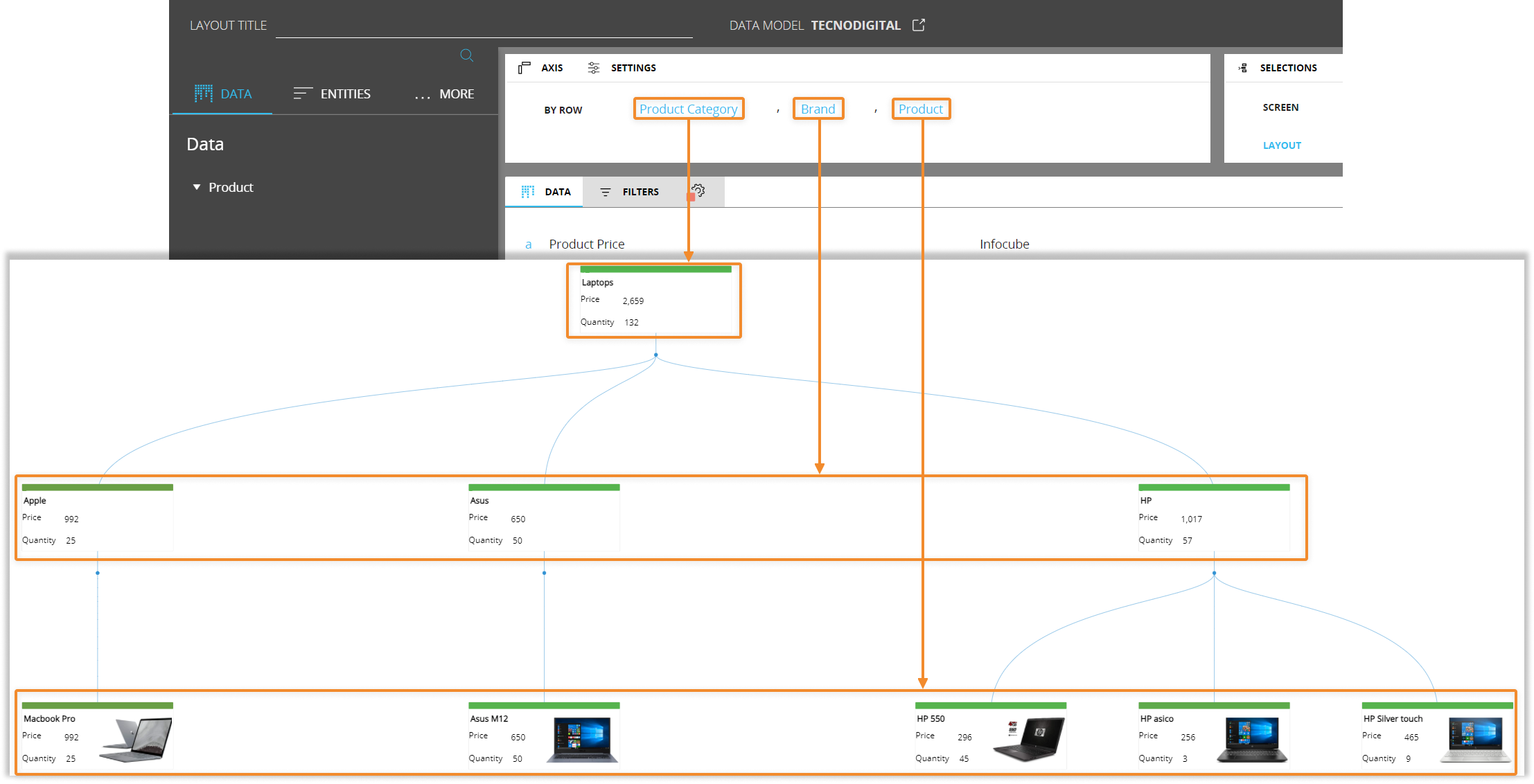
When the Entity that contains an unbalanced hierarchy is set By Row and is the most nested one, the Tree will reflect the unbalanced hierarchy.
The Data Area
The Data Area of a Tree Object Layout supports all kinds of Data Blocks (Cubes, Algorithms, Entities, etc.). All Data Blocks settings are supported: for example, you can enable the Detail By option on one Block and the Color Alert option on another one.
Enabled options can change the data displayed in tree nodes or in the details popover. See next paragraph and Interacting with a Tree Object for more details
The data entry option can be enabled on Data Blocks, but data entry actions can only be performed in drill down windows.
The Object preview pane
Each Block set in the Data Area is instantly displayed as a rectangle within a box (node) in the Object preview pane, as shown in the following image.
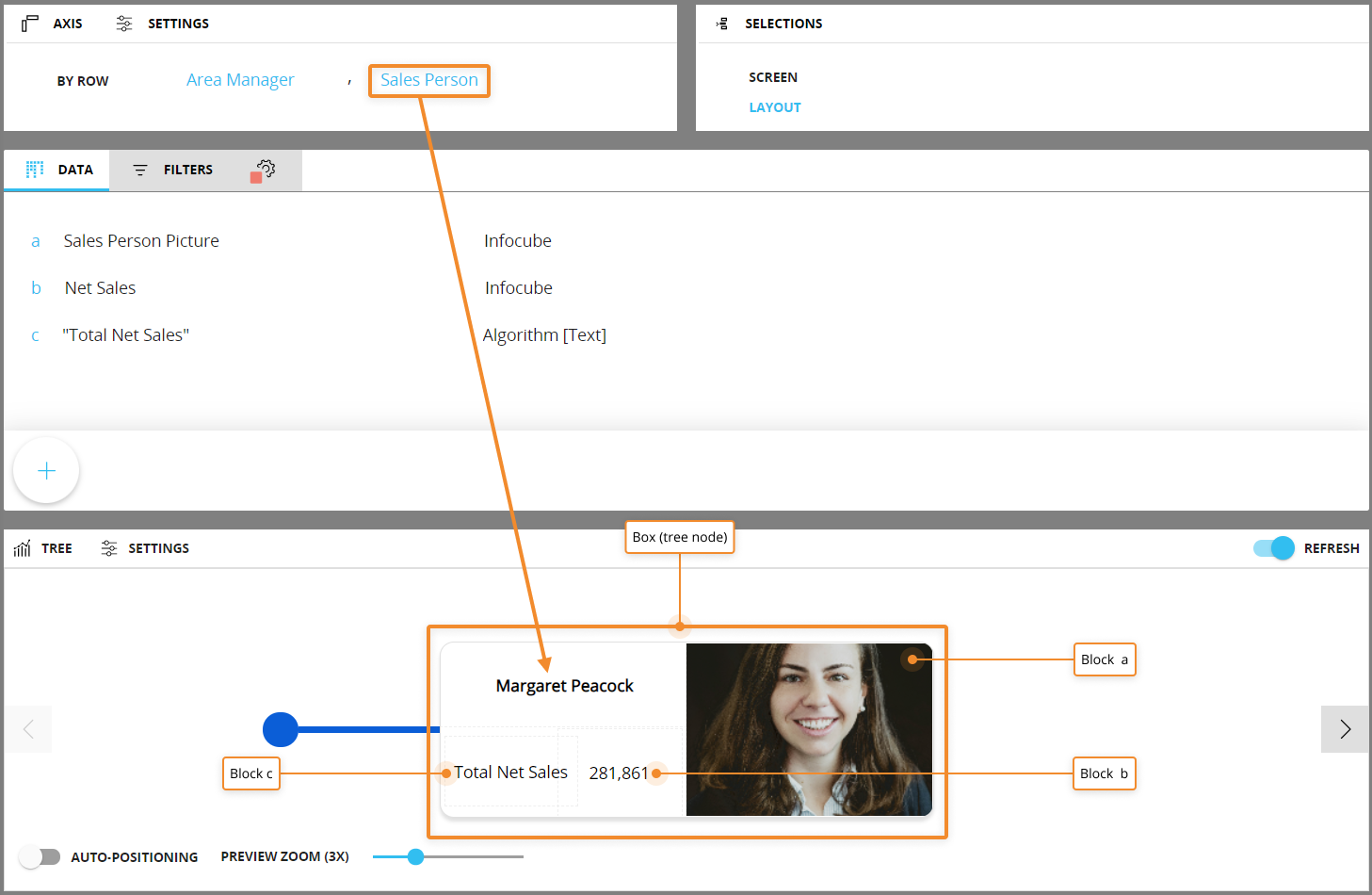
Each rectangle can be moved and/or resized inside the box, just like Objects on a Screen: the configured size and position of each rectangle will be replicated for each box (node) displayed in the Object area.
You can preview all boxes that will be displayed in the Object area by clicking the previous/next arrows on the sides of the pane.
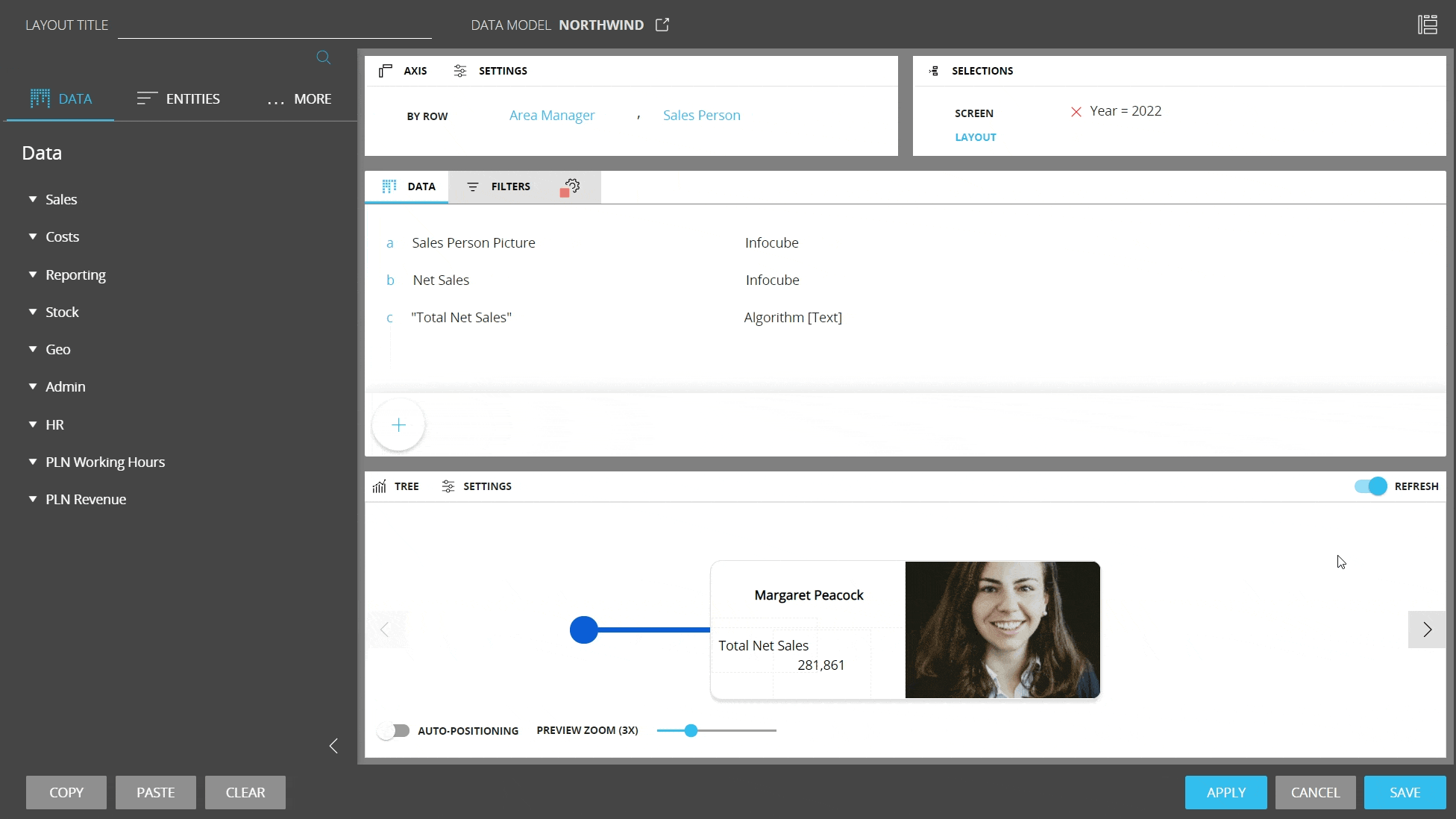
Object properties
In the Layout editor, under the Object properties panel, the Node options menu allows you to configure the shape and size of each node.
The following options are available:
- Shape. Choose from Rectangle or Circle
- Width. Enter the desired node width in pixels
- Height. Enter the desired node height in pixels
The Blocks alignment menu lets you configure how data from Entities and Blocks should be displayed in each rectangle within nodes.
From the Block dropdown menu, select the Cube or Entity (Label) you want to configure and set its horizontal and vertical alignment as desired.
To configure another item, select it from the Block dropdown menu first, then proceed to the alignment settings.
The Blocks action menu allows you to configure a Drill on one or more Data Blocks: click the pencil icon to bring up the drill configuration window.
See Drill-related paragraphs below for more details.
Tree properties and settings
Tree properties are available from the contextual right panel of the Screen editing page once the Object is selected.
The Tree Object supports all options common to all Screen Objects.
Properties specific to the Tree Object are highlighted in the following image and explained below.
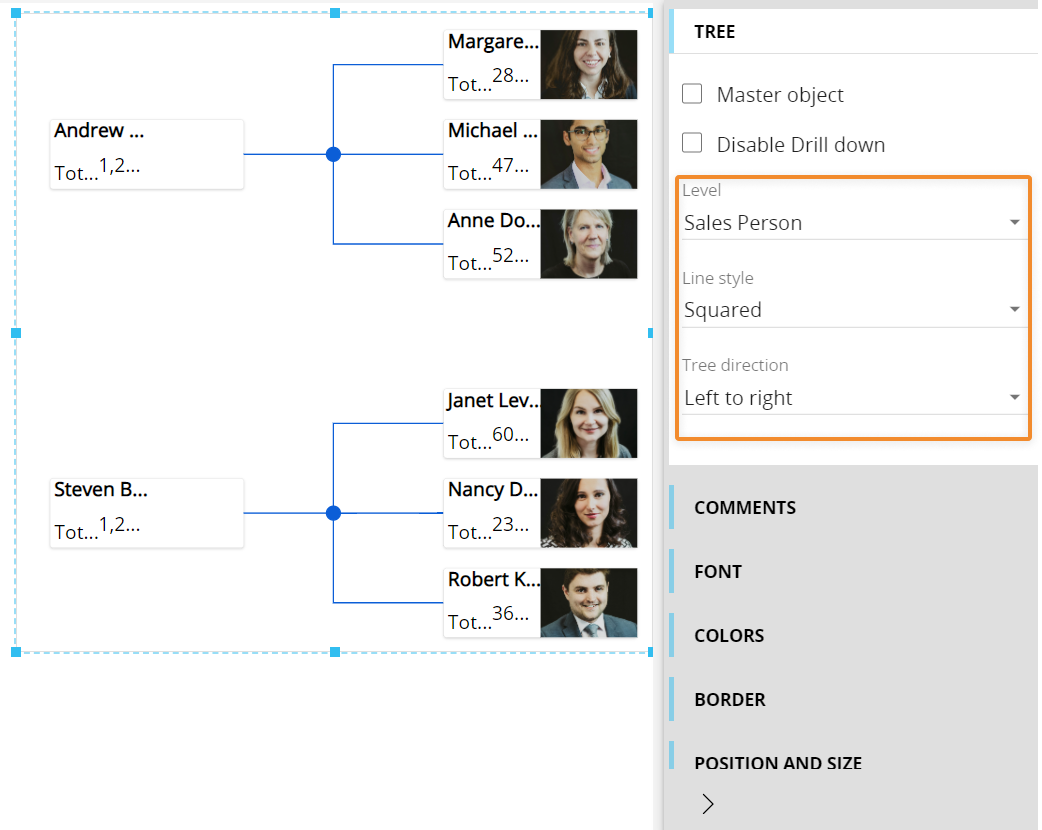
- The Level dropdown menu lets you configure the level of aggregation of the Tree: the Entity you select will be the leaf node of the diagram (i.e. the least aggregate series of data displayed on the Screen)
- The Line style dropdown menu lets you configure how connections lines will be plotted, Squared or Curvy
- The Tree direction menu lets you configure the direction of the diagram, Left to right or Top to bottom.
Interacting with the Tree Object in Design mode
In Design mode, the Tree Object provides the same interactive features available in Play mode, with a few notable differences regarding Drill functions.
You can also configure which options will be available in the contextual menu (sliding toolbar) in Play mode. To do so, hover over the Object area and click the contextual menu icon (![]() ) in the top left corner, then expand it by clicking on the downward facing arrow: the configuration panel is accessible from the gear icon in the top right corner.
) in the top left corner, then expand it by clicking on the downward facing arrow: the configuration panel is accessible from the gear icon in the top right corner.
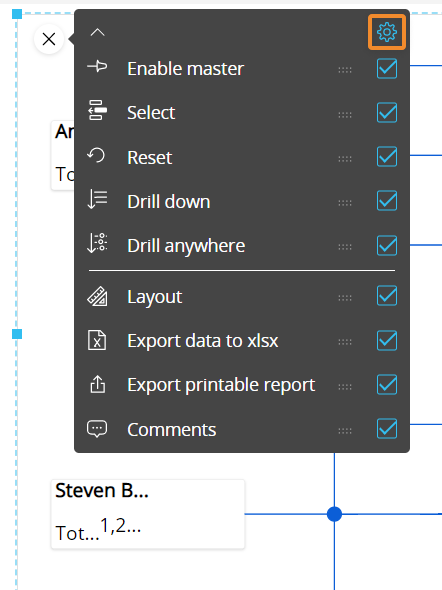
Default drill down
You can configure a drill down path that will be saved in the Tree configuration: that will be the default drill that will be performed in Play mode, when end users click on the Drill down icon (![]() ) or double-click on a box (a tree node).
) or double-click on a box (a tree node).
To configure the default drill, proceed as follows:
- Select a box (a tree node)
- Click on the Drill anywhere icon (
 )
) - From the pop up window, select the Entity to drill down on and click OK. The configured drill is performed
- Close the drill down window and save the Screen. The configured drill is now the default drill, both in Design and Play mode
End users will still be able to configure other drill down paths in Play mode, if they're allowed to do so. See next paragraph for more details.
Screen selections and selections made by the user using Selector Objects (if any) also apply to data in Drill down windows.
The Drill down configuration process can also be started by double-clicking on a box (a tree node).
Limit Drill down entities
You can limit drill down paths that end users are allowed to configure by selecting the Entities the user can drill down on.
To do so, check the "Limit drill down entities" checkbox in the drill anywhere configuration window and select the Entities you want to show to the end user. These entities will be the only ones available during the drill anywhere configuration in Play mode.
You can also configure a default drill down path from the Layout editor. To do so, proceed as follows:
- Select the Tree Object and open the Layout editor
- Click on SETTINGS in the Object preview pane to open the Object properties panel
- Under the Blocks action menu, select the pencil icon to configure a drill down on one or more Data Blocks as described in bullet point n° 3 of the previous bulleted list
- Save the Layout.
Drill-to-screen
To allow users to drill-down from a tree node to another Screen of the same Capsule with a selection on the member of the Entity displayed in the node, proceed as follows:
- Select a box (a tree node)
- Click on the Drill anywhere icon (
 )
) - From the pop up window, select the Screen tab and choose the destination Screen. Check the "Same tab" checkbox to open the destination Screen in the same browser tab.
- The Drill to screen mode, if enabled, will open the destination Screen with a selection on the member of the Entity displayed in the node when the user double-clicks on it or selects it and clicks on the Drill-down icon (
 )
)
Screen selections and selections made by the user using Selector Objects (if any) also apply to data in the target Screen.
- The Go to screen mode, if enabled, will open the destination Screen when the user double-clicks on box (a tree node) or selects it and clicks on the Drill-down icon (
 ). The destination Screen won't inherit any selection from the Tree
). The destination Screen won't inherit any selection from the Tree - The Dynamic screen option allow to select a Block (an algorithm) to dynamically change the Screen navigation based on another Block values (a text cube containing Screen names)
- The Drill to screen mode, if enabled, will open the destination Screen with a selection on the member of the Entity displayed in the node when the user double-clicks on it or selects it and clicks on the Drill-down icon (
- Click OK to save the Drill-to-screen configuration.
The Drill-to-screen configuration process can also be started by double-clicking on a box (a tree node).
You can also configure a Drill-to-screen with a selection filter applied based on the member of the Entity displayed in the node from the Layout editor.
To do so, proceed as follows:
- Select the Tree and open the Layout editor
- Click on SETTINGS in the Object preview pane to open the Object properties panel
- Under the Blocks action menu, select the pencil icon to configure a Drill-to-screen on one or more Data Blocks as described in bullet point n° 3 of the previous bulleted list
- Save the Layout.
The drill action will be triggered only if the user clicks on the rectangle corresponding to the Block where the Drill-to-screen has been configured.
This feature allows you to nest your analysis in a more powerful way than the standard drill-down, which only changes the level of granularity of a report. In a Drill-to-screen navigation the data represented (values, indexes) and types of objects (Charts, Dashboards, Data Views) may vary as the user drills from a top level view to another Screen at a more detailed level.
Drill-procedure
It is possible to trigger a Procedure from a tree node Object when the user double-clicks on it. The Procedure is launched with a selection filter applied based on the member of the Entity displayed in the node.
If a Drill-procedure containing two or more Procedures is configured, when the user double-clicks on a tree node a pop-up window will allow the selection of the Procedure to be performed.
To configure a Drill-procedure on the Tree nodes, proceed as follows:
- Select a box (a tree node)
- Click on the Drill anywhere icon (
 )
) - From the pop up window, select the Procedure tab and choose the desired Procedures.
- If the checkbox in the middle is unchecked, the dropdown menu on the left allows to choose from Procedures saved at the Capsule level
- If the checkbox in the middle is checked, select a Data model from the dropdown menu on the right. By doing so, only Procedures belonging to the chosen Data model will be shown in the dropdown menu
Click the ADD button on the right. Repeat the process for each procedure you want to add to the drill
- Click OK to save the Drill-procedure configuration.
The Drill-procedure configuration process can also be started by double-clicking on a box (a tree node).
You can also configure a Drill-procedure with a selection filter applied based on the member of the Entity displayed in the node from the Layout editor.
To do so, proceed as follows:
- Select the Tree Object and open the Layout editor
- Click on SETTINGS in the Object preview pane to open the Object properties panel
- Under the Blocks action menu, select the pencil icon to configure a Drill-procedure on one or more Data Blocks as described in bullet point n° 3 of the previous bulleted list
- Save the Layout.
Screen selections and selections made by the user using Selector Objects (if any) also apply to data in the triggered Procedure.
The Procedure will be triggered only if the user clicks on the rectangle corresponding to the Block where the Drill-procedure has been configured.
Drill through
It is possible to execute a Drill through from a tree node, when the user double-clicks on it. The Drill through is executed with a selection filter applied based on the member of the Entity displayed in the node.
Drill throughs are configured in the Drill through section of the Data model.
To configure a Drill through on the tree nodes, proceed as follows:
- Select a box (a tree node) and click on the Drill anywhere icon (
 )
) - From the pop up window, select the Drill through tab and choose the desired Drill through
- Click OK to save the Drill through configuration.
The Drill through configuration process can also be started by double-clicking on a tree node.
You can also configure a Drill through with a selection filter applied based on the member of the Entity displayed in the node from the Layout editor.
To do so, proceed as follows:
- Select the Tree Object and open the Layout editor
- Click on SETTINGS in the Object preview pane to open the Object properties panel
- Under the Blocks action menu, select the pencil icon to configure a Drill through on one or more Data Blocks as described in bullet point n° 3 of the previous bulleted list
- Save the Layout.
Screen selections and selections made by the user using Selector Objects (if any) also apply to data in the Drill through.
The Drill through will be triggered only if the user clicks on the rectangle corresponding to the Block where the Drill through has been configured.
Learn more about: